2.5 COMPOSERS
Franz Joseph Haydn

Franz Joseph Haydn (1732-1809) was born in Rohrau on the Austro-Hungarian border. He began his musical career when he was six years old, singing in the choir of St. Stephan’s Cathedral in Vienna. When his voice changed he was replaced with his younger brother. He was so distraught he nearly followed his choirmaster’s suggestion that there was a way to remain a soprano forever. Only his father’s hurried arrival from Rohrau prevented him from becoming one of the court chapel’s castrati. Joseph spent the next few years making music in the streets of Vienna, giving lessons, practicing the violin in icy garrets, studying the works of Carl Philipp Emmanuel Bach on his rickety clavier, and composing. When he was 29 he entered the service of the great Hungarian Esterházy Family and for the next 30 years was “a bird in a golden cage.” Haydn was hired to work just like the butlers, cooks or carpenters, and since he was not “high born” he had little chance of obtaining a position at court. He worked for Prince Nicolaus, one of the richest and most artistically inclined nobles of his time. In a damp marsh south-east of Vienna Nicolaus built a fabulous pleasure palace complete with canals, parks, grottoes, and concert halls. Here Haydn composed and performed. He used the enforced isolation of the palace to experiment with musical forms. He was instrumental in the development of the symphony and the string quartet. “1779 was a watershed year for Haydn, as his contract was renegotiated: whereas previously all his compositions were the property of the Esterházy family, he now was permitted to write for others and sell his work to publishers. Haydn soon shifted his emphasis in composition to reflect this (fewer operas, and more quartets and symphonies) and he negotiated with multiple publishers, both Austrian and foreign. This single document acted as a catalyst in the next stage in Haydn’s career, the achievement of international popularity. By 1790 Haydn was in the paradoxical, if not bizarre, position of being Europe’s leading composer, but someone who spent his time as a duty-bound Kapellmeister in a remote palace in the Hungarian countryside.2
By the time Haydn left the family thirty years later, aristocracy all over Europe were competing for the privilege of employing him. The autumn of his life blossomed with creation, travel, honors, and triumph everywhere he went. In England he became almost as great a favorite as Handle. In Austria he was chosen to compose the music for the new national anthem. When French troops occupied Vienna, Napoleon ordered a guard of honor posted before Haydn’s door. This did not flatter him. Even though he was ill, he asked to be lifted to the piano, where he played his country’s national anthem.
A central characteristic of Haydn’s music is the development of larger structures out of very short, simple musical motifs, often derived from standard accompanying figures. The music is often quite formally concentrated, and the important musical events of a movement can unfold rather quickly. Haydn’s work was central to the development of what came to be called sonata form. His practice, however, differed in some ways from that of Mozart and Beethoven, his younger contemporaries who likewise excelled in this form of composition. Haydn was particularly fond of the so-called “monothematic exposition”, in which the music that establishes the dominant key is similar or identical to the opening theme. Haydn also differs from Mozart and Beethoven in his recapitulation sections, where he often rearranges the order of themes compared to the exposition, and uses extensive thematic development.3
Haydn’s formal inventiveness also led him to integrate the fugue into the classical style and to enrich the rondo form with more cohesive tonal logic. Haydn was also the principal exponent of the double variation form—variations on two alternating themes, which are often major- and minor-mode versions of each other. Perhaps more than any other composer’s, Haydn’s music is known for its humor. The most famous example is the sudden loud chord in the slow movement of his”Surprise” symphony; Haydn’s many other musical jokes include numerous false endings (e.g., in the quartets Op. 33 No. 2 and Op. 50 No. 3), and the remarkable rhythmic illusion placed in the trio section of the third movement of Op. 50 No. 1.4
Haydn: Symphony No. 94, ‘Surprise’, 2nd movement 6:34 5
If you receive an error with the link above, use the following link https://www.youtube.com/watch?v=lLjwkamp3lI
Symphony No 94, his 94th, was written when he was 59. We call it the Surprise Symphony because of the sudden explosion of the orchestra in the slow movement just when eight bars of soft music followed by seven bars of even softer music have lulled the listener into expecting silence. Haydn is said to have pointed to that particular passage in the score and remarked with a laugh, “That’s where all the women will scream.” Listen for the joyful wanderings from the initial key, the gaiety given to the stately minuet, and the “conversations” between strings and other instruments.
“Haydn’s work is identified by a catalogue number created by Anthony van Hoboken. So each of Haydn’s works is assigned a Hoboken number which is abbreviated with the letter H or Hob. His string quartets also have Hoboken numbers but they are also identified by “opus” numbers which indicate groups of quartets that were published together. So for example the string quartet Opus 76, No. 3 is the third of the six quartets published in 1799 as Opus 76.”6
Wolfgang Amadeus Mozart
Wolfgang Amadeus Mozart was born on 27 January 1756 to Leopold Mozart (1719–1787) and Anna Maria Pertl (1720–1778), at 9 Getreidegasse in Salzburg, Austria, then part of the Holy Roman Empire. He was the youngest of seven children, five of whom died in infancy. Mozart was baptized the day after his birth at St. Rupert’s Cathedral. Leopold began teaching Wolfgang’s older sister to play the clavier and at age four Wolfgang began to show his advanced skills in playing and composing music. When Wolfgang was six, his father took him and his sister to the courts in Vienna, Prague, Munich, Paris, The Hague, and Zurich. There he met important musicians and was accepted to the Accademia Filarmonica in Bologna, Italy. In Rome he heard Gregorio Allegri’s Miserere twice in performance in the Sistine Chapel and wrote it down from memory, producing the first unauthorized copy of the closely guarded property of the Vatican. His father hoped that the tour of Italy would result in job offers, but that did not happen. Instead Mozart was employed as a court musician by the ruler of Salzburg and created and played symphonies, string quartets, masses, operas, violin concertos and piano concertos. Mozart was a musical prodigy: at age eight he wrote a symphony, at eleven an oratorio, and at twelve his first opera. His first serious opera was written when he was fourteen and it was performed twenty times in Milan with great success.
In 1782 Mozart married Constanze Weber, against the wishes of his father. “The couple had six children, of whom only two survived infancy, Karl Thomas Mozart and Franz Xaver Wolfgang Mozart. In 1782 and 1783 Mozart became well acquainted with the work of Johann Sebastian Bach and George Frederic Handel through the influence of Gottfried van Swieten who owned many manuscripts of the Baroque masters. This music inspired Mozart’s personal musical language of the future.”7 Mozart met Joseph Haydn in Vienna in 1784 and they became friends, sometimes playing together in string quartets. He and Constanze lived way above their meager means and they were often in debt. The Austro-Turkish War interfered with all musical life in Vienna, where they lived, and it also lessened the amount of money the aristocracy had to spend on musical activities. At this time “social power moved from court and Church to the public arena, and traditional patronage and the functional reasons for writing music began to wane. Arguably the most significant shift occurred with

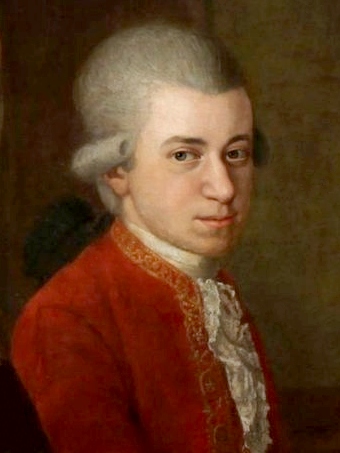
the commercialization of music, which was rooted in capitalist ideals of free enterprise and the market-driven economy. Many segments of musical life were shaped by the new mercantile emphasis: music publishing, music magazines, concert series, instrument makers, critics, entrepreneurial composers and independent performers and performing groups. Behind it lay the Enlightenment notion of the autonomous individual with unlimited potential if unfettered by socio-political restraints.”10 So musicians like Mozart, Haydn and Beethoven both benefited from and suffered from these changes.
Mozart was a musical genius. He wrote masterpieces in all of the musical forms of the time, including symphonies, string quartets, piano concertos, and operas. He often composed music entirely in his head, and then paused to write it down. He worked best under pressure. The elaborate overture to his opera Don Giovanni was written down the night before the first performance. While he scribbled the notes down his wife kept him awake by feeding him punch and telling him stories. In the morning the copyist had the finished manuscript and that evening it was played by sight, without a rehearsal. He wrote music as other people wrote letters, and once the music was composed in his head, he could put it onto paper almost without correction. He could even talk with others while notating a score. The more than 600 works of art done by Mozart were catalogued during the 19th century by Ludwig von Kochel. For this reason it is customary to refer to a Mozart work by the “K” number that indicated its chronological place in his body of work.
He was a master of the opera. Few composers have matched his ability to coordinate music and stage action. His dramatic works reveal a keen sense of theater, an inexhaustible gift of melody, and a genius for creating characters through tone. Most of his operas were comedies written in German or Italian. The Italian operas are entirely sung and the German operas include spoken dialogue, as was common in German opera of the time. His comic operas contain both humorous and serious characters.
Opera came to be much more important during this time. Its appeal had been for the upper classes, but now the subject matter of the opera began to change and deal more with the lower classes, and it began to attract the more popular audiences rather than the very rich. Opera is a combination of the libretto, which is the text of the work, and the music, which is written to complement the story and develop the characters. Opera singers depict characters overwhelmed by love, hate, lust, hatred and revenge. They wear fantastic disguises and commit extra-ordinary acts of violence.
An opera demands performers who can sing and act simultaneously. On stage are solo singers, secondary soloists, a chorus, and sometimes dancers. There may also be “supers” or “supernumeraries” who don’t sing but who carry spears, fill out crowds, drink wine, or do other things that add to the effect. Scenery, lighting, and stage machinery are intricate. There may be the illusion of fires, floods, storms, and supernatural effects. A large opera’s personnel, from conductor to stage director and assorted vocal coaches, rehearsal accompanists, technicians, and stagehands, may reach a total of several hundred people.
Most opera begins with an overture or prelude, which is often a preview of music from the rest of the opera to come. An aria is a song for a soloist written to express an emotional state. These are often Melismatic. A recitative is a vocal line that imitates the rhythms and pitch of speech. Words are sung quickly and clearly, often with repeated tones. It carries the action forward faster than an aria. It is syllabic and therefore faster. There is often a prompter, invisible to the audience, who cues and reminds the singers of words or actions. There may be ensembles when three or more singers perform together. Often the ensemble may portray several conflicting emotions at the same time in the same music.
The music makes the emotions and the story seem real. It evokes the haughtiness of a countess or the simplicity of a peasant girl. It creates a dramatic entrance for an outraged father, depicts the tension behind sword thrusts in a duel, and portrays the bleakness of a winter dawn. A great composer is a master of musical timing and characterization and has a keen sense of the theater, knowing just when to have a character sing a simple phrase of a soaring melody, when to provide a stirring chorus or a graceful dance. Through the music the composer paces the drama, controlling the speed of gestures, entrances, exits, and stage movements.
One of Mozart’s most powerful operas is Don Giovanni, which was written in 1787. It is the tale of Don Juan, the legendary Spanish lover whose tale had been told in many other forms before Mozart presented his version. Mozart’s Don Juan is a charming but ruthless nobleman who stops at nothing to satisfy his sexual appetite. Leporello is his comic servant who grumbles and dreams about being in his master’s place. Donna Anna is a young noblewoman who is raped by Don Juan. Her father, the Commendatore, hears her cries and rushes to her side, but is challenged to a duel by Don Juan and is killed. In the course of the action, the deceased Commendatore threatens Don Juan to repent or pay for his sins. The finale of Act II, the concluding section of the opera, finds Don Juan enjoying good food and music in his banquet hall while he listens to his private band play three hit songs, including one from Mozart’s opera The Marriage of Figaro. Listen to a five minute version of Don Giovanni in the YouTube version below, and then listen to the concluding minutes of the opera as Don Juan is captured by the devil and carried down to hell to pay for his crimes. Mozart can awaken a character to life by a phrase or rhythmic pattern. His emotional range is enormous. Within a short period of time his music can be spirited and profound, serene and agitated, ethical and diabolical.
Mozart – Don Giovanni in 5 minutes 5:1011
If you receive an error with the link above, use the following link https://www.youtube.com/watch?v=DVjUBzesjEA

Mozart’s last year was a very productive one. He composed his opera The Magic Flute and many concertos, motets, and string quartets. He began to pay his way out of debt and no longer borrowed large sums of money. He had also joined the Freemasons and wrote some works for them. He was still working on his Requiem, but it was unfinished at his death. He was quite ill in November of 1791 and died in his home on 5 December at the age of 35. The New Grove describes his funeral: “Mozart was interred in a common grave, in accordance with contemporary Viennese custom, at the St. Marx Cemetery outside the city on 7 December. If, as later reports say, no mourners attended, that too is consistent with Viennese burial customs at the time; later Jahn (1856) wrote that Salieri, Süssmayr, van Swieten and two other musicians were present. The tale of a storm and snow is false; the day was calm and mild.”13
The cause of Mozart’s death cannot be known with certainty. The official record has it as “hitziges Frieselfieber” “severe military fever”, referring to a rash that looks like millet seeds, more a description of the symptoms than a diagnosis of the cause. Researchers have posited at least 118 causes of death, including acute rheumatic fever, streptococcal infection, trichinosis, influenza, mercury poisoning, and a rare kidney ailment. Mozart’s modest funeral did not reflect his standing with the public as a composer: memorial services and concerts in Vienna and Prague were well-attended. Indeed, in the period immediately after his death, his reputation rose substantially: Solomon describes an “unprecedented wave of enthusiasm for his work.14
Mozart, Symphony 40 26:2415
If you receive an error with the link above, use the following link https://www.youtube.com/watch?v=JTc1mDieQI8
Ludwig van Beethoven

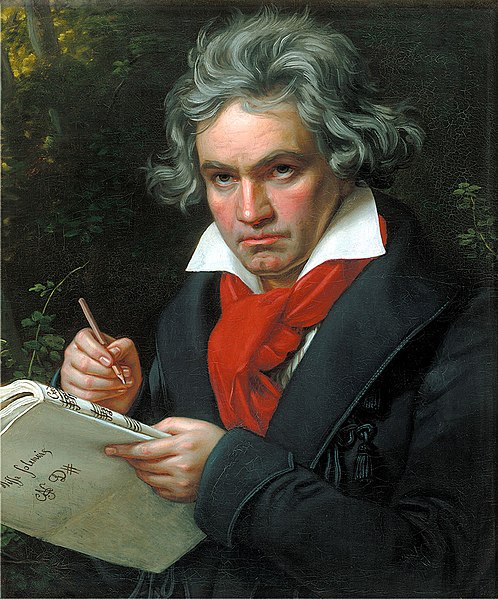
Beethoven was a German composer and pianist, born in Bonn which was part of the Holy Roman Empire at the time. He traveled to Vienna hoping to study with Mozart, but it is not certain if they ever met. Shortly after that Beethoven’s mother became ill and died and he became responsible for the care of his younger siblings. He studied with Haydn and in 1792 moved to Vienna where he became well known as a virtuoso pianist. As Mozart had recently died, Haydn thought of himself as a successor to the deceased genius, so he studied Mozart’s work and wrote with Mozart’s characteristics. By the end of 1800 Beethoven was well known and much in demand from patrons and publishers.
In around 1796 when Beethoven was about 26 years old, he began to lose his hearing due to a form of tinnitus, or severe ringing in his ears. “Over time, his hearing loss became profound: at the end of the premiere of his Ninth Symphony in 1824, he had to be turned around to see the tumultuous applause of the audience because he could hear neither it nor the orchestra. Beethoven’s hearing loss did not prevent him from composing music, but it made playing at concerts—a lucrative source of income—increasingly difficult. After a failed attempt in 1811 to perform his own Piano Concerto No. 5 (the “Emperor”), which was premiered by his student Carl Czerny, he never performed in public again until he conducted the Ninth Symphony in 1824.”18 One of the things Beethoven did to communicate with others was to have others write their thoughts and questions to him in books. He would then answer them verbally or write an answer. Some of these books are still in existence and are a good source of information about his work.
Although he never married, Beethoven sought and was given custody of his nephew Carl and spent much time and money in the effort. He was romantically involved from a distance with several women, but due to the difference in their social class they were not able to marry. Some of his most famous works, such as Moonlight Sonata and Fur Elise, are dedicated to them.
Beethoven’s Moonlight Sonata – 1801 5:2319
If you receive an error with the link above, use the following link https://www.youtube.com/watch?v=n-pwPIRW9fY&list=PLJFJk9LXgFfpL-FMeWoEqJT8UWhw33NpW&index=3
Beethoven’s Fur Elise – 1810 3:51 20
If you receive an error with the link above, use the following link https://www.youtube.com/watch?v=e4d0LOuP4Uw&list=PLJFJk9LXgFfpL-FMeWoEqJT8UWhw33NpW&index=6
Beethoven was attracted to the ideals of the Enlightenment. His work is considered by many to be a bridge between the Classical works of Mozart and Haydn to all of the Romantic works that followed. His later works conveyed the story of the individual, free man. He stayed within the boundaries of classical art but his innovations led the way to increased ways of expressing emotion. He expanded the way he used the classical forms and created more complex work. We will look at him again in the chapter on Romantic composers.
Elisabeth Jacquet de la Guerre
There were of course women who composed and performed music during this time. “Women composers, at least those who actually became composers and whom we know about, usually came from musical or artistic homes.”21 If a woman did not have the encouragement of her father, brothers, or husband, she had very little access to the musical world. Elisabeth Jacquet de la Guerre was born in Paris in 1665 and died in Paris in 1729. She was a composer, harpsichordist, pianist, singer, and organist. “She was born into a family of artisans that included both musicians and instrument builders.”22
François de Troy, who painted this portrait of Jacquet, as she was known, was the principal painter to King James II in exile at Saint-Germain-en-Laye. He was also the Director of the Royal Académie of painting and sculpture. At age 15 Jacquet was sent to work for Madame de Montespan, King Louis XIV’s official mistress. Jacquet “left the court in 1684 and married Marin de la Guerre, a Parisian harpsichordist, organist, music teacher, and composer from a well-established family of professional musicians. She had one son with him who died at age 10 and her husband died in 1704.”23
Jacquet wrote an opera, “Céphale et Procris (based on the myth of Cephalus and Procris, adapted from Ovid’s Metamorphoses), a tragédie en musique that was much like the work of Jean-Baptiste Lully. It is thought to have premiered at the Paris Opéra on March 15, 1694, though this date is transmitted only in a 19th-century source. Although the opera did
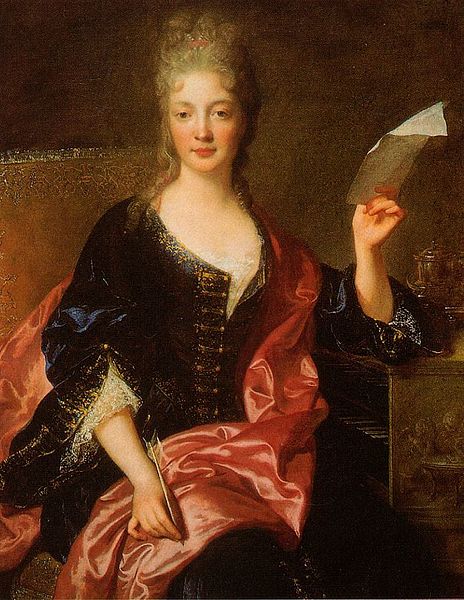
not meet with much success, it has the distinction of being the first opera composed by a woman in France, and the music was published in the same year. Jacquet performed in concerts at her home and her surviving compositions, whether in print or manuscript – likely represent only a fraction of the music she actually wrote. Her talents were widely recognized in her own lifetime and thereafter, and her unusual status as a woman in the world of professional music did not go unnoticed by her contemporaries.”25 She died just a few years before composer Joseph Haydn was born. “Just before her death, Jacquet made a point of dictating her will, in which she bequeathed her three portraits to her nephews. One of them does appear in the post-mortem inventory, as does the instrument we see in this painting, a ‘large Flemish dual-keyboard harpsichord’ which we see located in a salon which doubtless served as a dining room. It attests to the Parisian taste of the time for instruments built in Antwerp, a trend which began in the 17th century with the great musicians of the first French harpsichord school.”26
Jacquet de Guerre, Violin Sonata No 1 – Adagio 6:44
If you receive an error with the link above, use the following link https://video.search.yahoo.com/search/video?p=elisabeth+jacquet+de+la+guerre&fr=yhs-invalid#id=60&vid=01634eff02efdb671b68935b3f1d4595&action=view
Jacquet de Guerre Violin Sonata No.2, 1st movement 1:2327
If you receive an error with the link above, use the following link https://www.youtube.com/watch?v=LcUhbHhZj0I
Anna Amalia of Prussia (1723-1787)
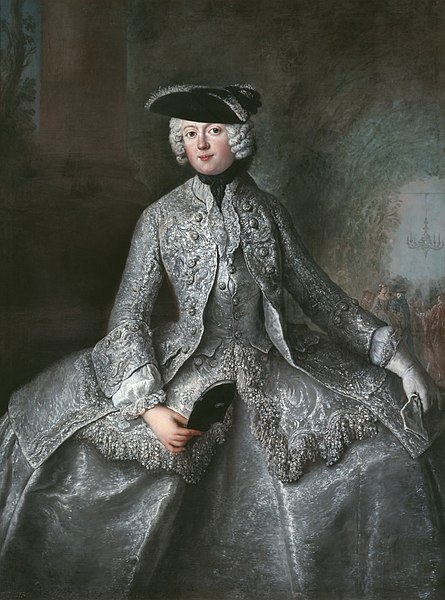
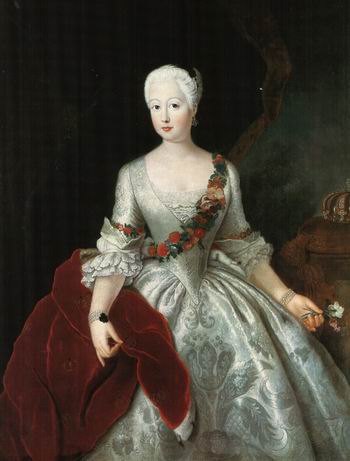
Anna Amalia of Prussia was born in a Berlin castle on November 9th 1723 and died in Berlin on March 30th 1787. The youngest sister of Frederick the Great, she seems to have sought and received his advice on musical matters. A music exercise book, dated 1735, which she shared with her sister Luise Ulrike, indicates an early commitment to musical studies, but it is not certain precisely when her formal musical training began. By 1740 she and Ulrike were receiving regular instruction from the cathedral organist, Gottfried Hayne (1684–1758), and this continued until 1742. Anna Amalia apparently reached a high level of accomplishment as a player of stringed keyboard instruments and in about 1755 she began to devote herself enthusiastically to playing the organ. Although contemporary reports, including her own letters, suggest that she also played the lute, the violin and the flute, they indicate that she was far less proficient on those instruments.30 Princess Anna Amalia’s older brother, Frederick the Great, is the one who is remembered for his musical accomplishments. The two shared a love of music despite the fact that their music-hating father forbade their musical studies. “Anna Amalia was a product of the Enlightenment, a period when women played an important role in public affairs. She grew up in a rich cultural environment and was trained by court musicians. Anna Amalia fell in love and secretly got married in 1743. “When Anna Amalia’s brother discovered her secret marriage (because Anna Amalia became suddenly pregnant), he had the marriage annulled and shipped his sister off to Quedlinburg Abbey to have her child out of wedlock. Even though they were no longer married Anna Amalia and her ex-husband von der Trenck continued to correspond.”31 Anna Amalia later became Abbess of the Abbey at Quedlinburg but because of her high social standing she was allowed to leave the Abbey and live in more aristocratic surroundings. Most accounts agree that Anna Amalia did not begin composing until her mid-40s. She concentrated on composing marches for military regiments and generals, a genre rarely adopted by women.
Anna Amalia produced a small body of works, but her greatest contribution to music was actually her work as a collector and curator: she preserved volumes of works by such greats as Bach, Handel and Telemann. Known as the Amalien Bibliothek, it exists today in its entirety in the Staatsbibliothek zu Berlin. This collection reveals her high level of musical education and her conservative musical taste. Her library was divided between East Germany and West Germany at the end of World War II, but in May of 2002 The Berlin Philharmonic celebrated the official reunification of the 5,100 musical manuscripts from the Ukraine.32 Anna Amalia was also a patron of music, and musicians throughout Germany were employed by the court. Under her influence, music flourished in the Prussian court, a rich heritage from which all Germany would benefit.”33
Princess Anna Amalia of Prussia 4:3734
If you receive an error with the link above, use the following link https://www.youtube.com/watch?v=Hmbt9h4QreA
Rose Adélaïde Ducreux
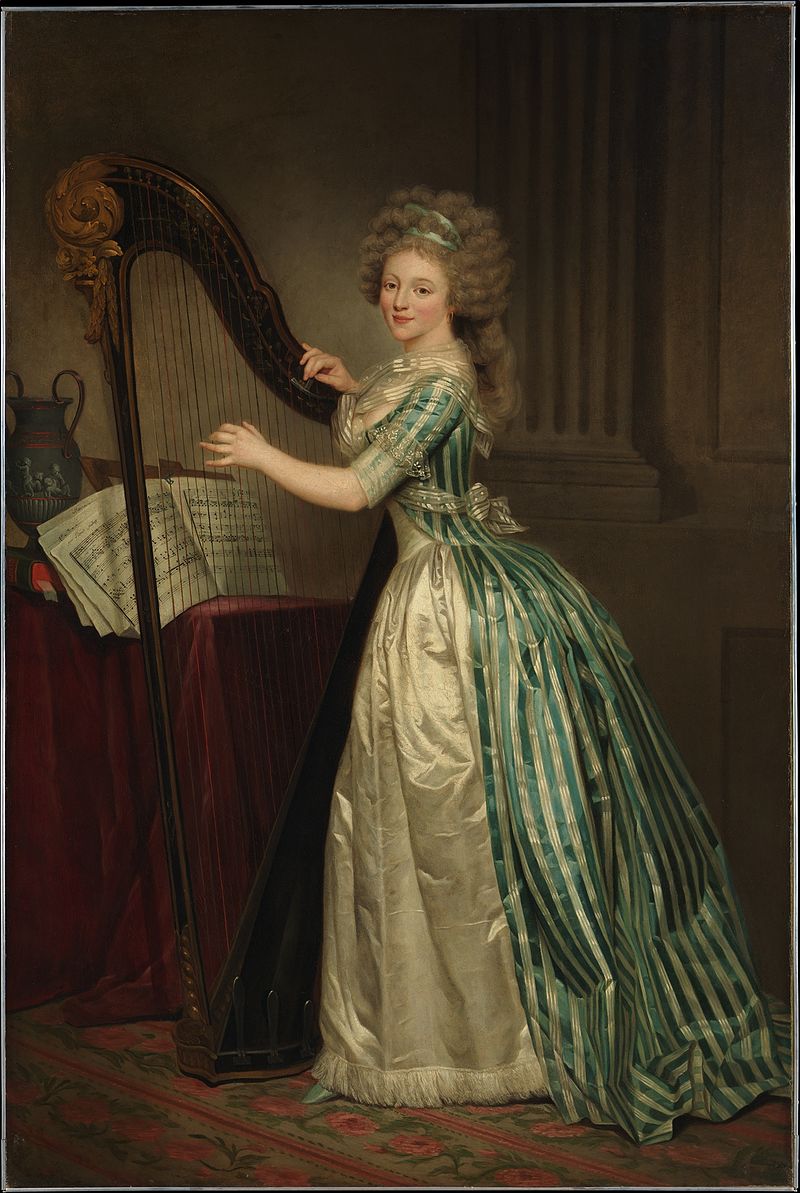

“Though the art world of the 18th century was dominated by men, quite a few women were trained as artists and held their own in exhibits and sales. One of these women was Rose-Adélaïde Ducreux, whose portrait of herself tuning her harp is a gorgeous and historically fascinating work of art. Rose was born in Paris in 1761, the daughter of the painter Joseph Ducreux, who was a successful portraitist at the court of Louis XVI of France. Coming from a wealthy family, Rose received a well-rounded education and was accomplished as a composer and performer as well as a portraitist. Rose’s paintings were displayed in several exhibits, beginning in the Paris Salon of 1791, the first year in which members of the public were permitted to display their own paintings. Her work was displayed in Paris in several exhibits for the rest of the decade, where they were received favorably. Self portrait with a Harp at the Salon is a remarkable painting not only for its beauty but for the historical insight it provides. Rose stands, not playing the harp, but seemingly interrupted from the middle of tuning (she holds the tuning key in her right hand). Obviously painted by someone intimately familiar with the instrument, the harp is depicted with red strings for C and dark strings for F, and with nearly photorealistic pedals. The strings are tied to the top of the harp in a slightly untidy, realistic way — how Rose must have tied her own instrument’s strings. The song laying (sic) on the table, “Tender Love”, suggests she also sings as she plays. Rose relocated to the colony of Saint-Domingue (in modern-day Haiti) after marrying Francois-Jacques Lequoy de Montgiraud, where she sadly died of yellow fever at the young age of 41, in 1802.”37

